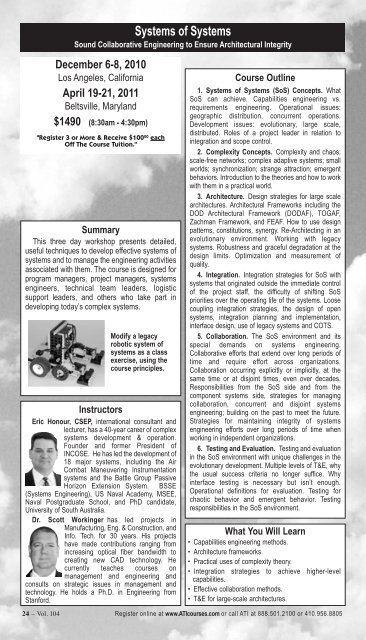Systems Engineering - ATI
Systems Engineering - ATI
Systems Engineering - ATI
Create successful ePaper yourself
Turn your PDF publications into a flip-book with our unique Google optimized e-Paper software.
<strong>Systems</strong> of <strong>Systems</strong><br />
Sound Collaborative <strong>Engineering</strong> to Ensure Architectural Integrity<br />
December 6-8, 2010<br />
Los Angeles, California<br />
April 19-21, 2011<br />
Beltsville, Maryland<br />
$1490 (8:30am - 4:30pm)<br />
"Register 3 or More & Receive $100 00 each<br />
Off The Course Tuition."<br />
Summary<br />
This three day workshop presents detailed,<br />
useful techniques to develop effective systems of<br />
systems and to manage the engineering activities<br />
associated with them. The course is designed for<br />
program managers, project managers, systems<br />
engineers, technical team leaders, logistic<br />
support leaders, and others who take part in<br />
developing today’s complex systems.<br />
Modify a legacy<br />
robotic system of<br />
systems as a class<br />
exercise, using the<br />
course principles.<br />
Instructors<br />
Eric Honour, CSEP, international consultant and<br />
lecturer, has a 40-year career of complex<br />
systems development & operation.<br />
Founder and former President of<br />
INCOSE. He has led the development of<br />
18 major systems, including the Air<br />
Combat Maneuvering Instrumentation<br />
systems and the Battle Group Passive<br />
Horizon Extension System. BSSE<br />
(<strong>Systems</strong> <strong>Engineering</strong>), US Naval Academy, MSEE,<br />
Naval Postgraduate School, and PhD candidate,<br />
University of South Australia.<br />
Dr. Scott Workinger has led projects in<br />
Manufacturing, Eng. & Construction, and<br />
Info. Tech. for 30 years. His projects<br />
have made contributions ranging from<br />
increasing optical fiber bandwidth to<br />
creating new CAD technology. He<br />
currently teaches courses on<br />
management and engineering and<br />
consults on strategic issues in management and<br />
technology. He holds a Ph.D. in <strong>Engineering</strong> from<br />
Stanford.<br />
Course Outline<br />
1. <strong>Systems</strong> of <strong>Systems</strong> (SoS) Concepts. What<br />
SoS can achieve. Capabilities engineering vs.<br />
requirements engineering. Operational issues:<br />
geographic distribution, concurrent operations.<br />
Development issues: evolutionary, large scale,<br />
distributed. Roles of a project leader in relation to<br />
integration and scope control.<br />
2. Complexity Concepts. Complexity and chaos;<br />
scale-free networks; complex adaptive systems; small<br />
worlds; synchronization; strange attraction; emergent<br />
behaviors. Introduction to the theories and how to work<br />
with them in a practical world.<br />
3. Architecture. Design strategies for large scale<br />
architectures. Architectural Frameworks including the<br />
DOD Architectural Framework (DODAF), TOGAF,<br />
Zachman Framework, and FEAF. How to use design<br />
patterns, constitutions, synergy. Re-Architecting in an<br />
evolutionary environment. Working with legacy<br />
systems. Robustness and graceful degradation at the<br />
design limits. Optimization and measurement of<br />
quality.<br />
4. Integration. Integration strategies for SoS with<br />
systems that originated outside the immediate control<br />
of the project staff, the difficulty of shifting SoS<br />
priorities over the operating life of the systems. Loose<br />
coupling integration strategies, the design of open<br />
systems, integration planning and implementation,<br />
interface design, use of legacy systems and COTS.<br />
5. Collaboration. The SoS environment and its<br />
special demands on systems engineering.<br />
Collaborative efforts that extend over long periods of<br />
time and require effort across organizations.<br />
Collaboration occurring explicitly or implicitly, at the<br />
same time or at disjoint times, even over decades.<br />
Responsibilities from the SoS side and from the<br />
component systems side, strategies for managing<br />
collaboration, concurrent and disjoint systems<br />
engineering; building on the past to meet the future.<br />
Strategies for maintaining integrity of systems<br />
engineering efforts over long periods of time when<br />
working in independent organizations.<br />
6. Testing and Evaluation. Testing and evaluation<br />
in the SoS environment with unique challenges in the<br />
evolutionary development. Multiple levels of T&E, why<br />
the usual success criteria no longer suffice. Why<br />
interface testing is necessary but isn’t enough.<br />
Operational definitions for evaluation. Testing for<br />
chaotic behavior and emergent behavior. Testing<br />
responsibilities in the SoS environment.<br />
What You Will Learn<br />
• Capabilities engineering methods.<br />
• Architecture frameworks.<br />
• Practical uses of complexity theory.<br />
• Integration strategies to achieve higher-level<br />
capabilities.<br />
• Effective collaboration methods.<br />
• T&E for large-scale architectures.<br />
24 – Vol. 104 Register online at www.<strong>ATI</strong>courses.com or call <strong>ATI</strong> at 888.501.2100 or 410.956.8805

















